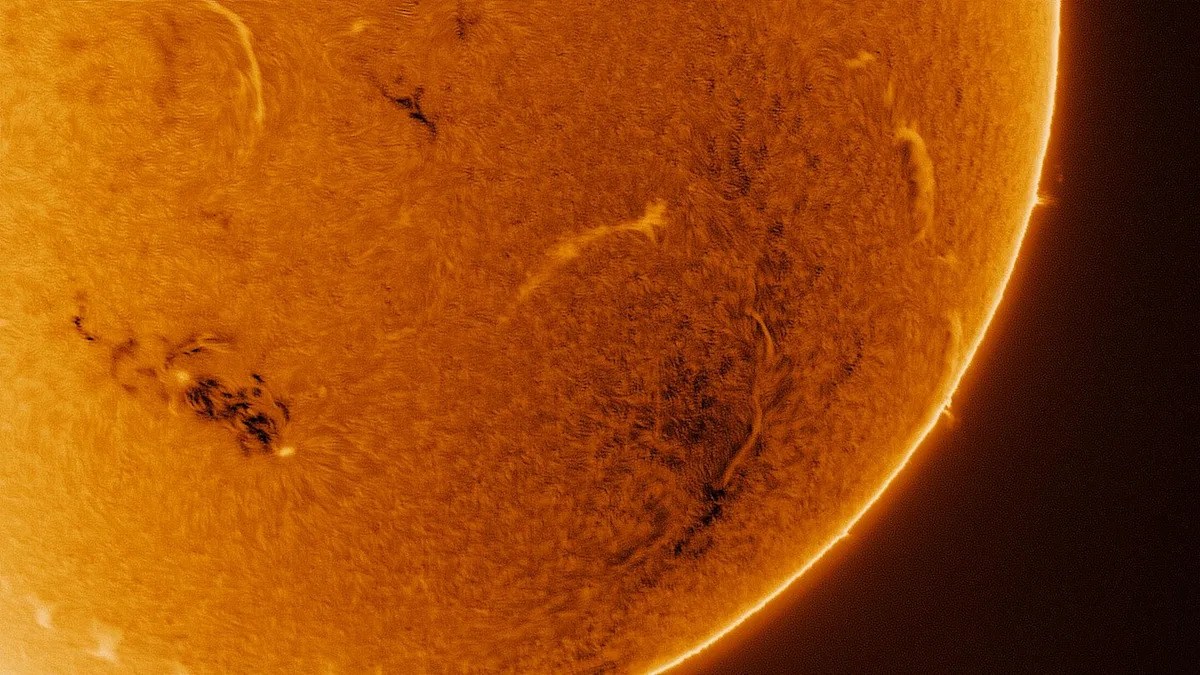Here’s what you’ll learn when you read this story:
-
Why sunspots are able to last so long has been a mystery for millenia, but a new observation technique revealed their secret.
-
The equilibrium between magnetic fields and pressure allows the solar blotches to remain stable anywhere from days to months.
-
Despite being darker, cooler regions of the sun, sunspots are related to its hot temper, and can help predict solar outbursts like flares and coronal mass ejections.
Sunspots were observed on the surface of our star centuries before Galileo suffered eye damage peering at them through his telescope. The first known records were written down by Chinese astronomers in 27 B.C., but observation may go even further back if Greek philosopher Anaxagoras really, ahem, spotted one in 467 B.C. While some of the ancients thought that these shadows on our star meant changes in the cosmos, sunspots are surprisingly stable—and now we know why.
Sunspots are actually byproducts of magnetic field chaos. Inside the sun’s convective zone, scorching plasma cools as it moves towards the solar surface, taking energy with it. This plasma becomes denser as it loses heat and sinks, forming cooler dark spots until heat from further inside the sun causes it to rise again. And all the while, magnetic fields keep twisting and breaking and rearranging themselves. This explains the association of sunspots with the outbursts we know as solar flares and coronal mass ejections, which can release enough electromagnetic radiation to threaten satellites and electrical infrastructure on Earth.
More stable sunspots can possibly give more insight to the solar activity cycle, which is about 11 years long and peaks during a solar maximum. Previous explanations for their stability suggested an equilibrium between magnetic fields and gas pressure, but magnetic turmoil has long made this difficult to observe. Now, an international research team using Germany’s GREGOR solar telescope has finally cleared up the hazy observations of sunspots with a new method that removes interference from Earth’s atmosphere and reveals strikingly clear images.
Led by researchers from the Institute of Solar Physics in Freiburg, Germany, the technique—originally developed at the Göttingen Max Planck Institute for Solar System Research—has achieved what only (much more expensive) satellites were able to do before: it made the analysis of polarized light from the Sun possible. Polarization is the phenomenon of light’s electric field moving back and forth, perpendicular to the direction in which the light wave itself is headed, and light is said to be polarized when it continues to propagate one way (as opposed to scattering). By taking a closer look at polarized light, the team was able to tell exactly where it was coming from within sunspots, and what was going on inside.
It turned out that the equilibrium in sunspots is a balance of pressure and magnetism. Magnetic fields are strongest when electrons remain unattached, but as more pressure is exerted, it forces them into pairs and weakens the magnetic field. Just enough pressure balances out the strength of magnetic fields and keeps the sunspots intact for extended periods. This is known as magnetohydrostatic equilibrium, which describes the properties of a gas or fluid (such as solar plasma) in a magnetic field. Because solar plasma can conduct electricity, it supports the magnetic field it interacts with.
“[Our] results provide decisive observational and theoretical support for the idea that sunspots slowly evolve around an equilibrium state and are [in] magnetohydrostatic equilibrium, thereby helping to explain their long lifespans,” the researchers said in a study recently published in Astronomy & Astrophysics.
Understanding why sunspots—and the solar turbulence that comes with them—can hang around for so long will help us better forecast space weather and possibly prevent blackouts, damage to satellites, and threats to astronauts’ health.
You Might Also Like
